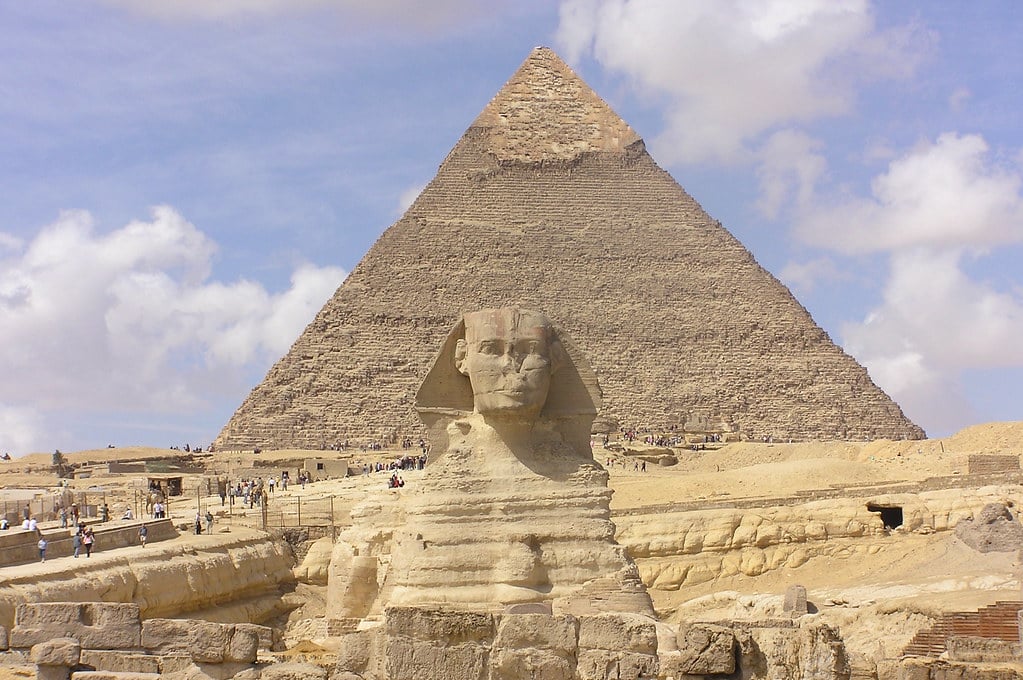
The mystery of the construction of the pyramids has fascinated researchers for quite some time. People throughout the ages have wondered how these limestone structures were built with such speed and precision.
This has even led to some strange theories. New electron microscopy and topographic studies are solving the mystery, with the proposal of more acceptable theories.
The Great Pyramid of Khufu stands 146 meters tall, weighs six million tons, and is composed of nearly 2.3 million granite and limestone blocks weighing up to eighty tons each.
The structure is of a nearly perfect level and square and the blocks so close-fitting that there is no space between them. Most astonishing of all, the work appears to have been completed in less than twenty years.
How were the limestone blocks carried up?
The mystery involving Ancient Egyptian culture and their funerary rites has given credence to various strange theories over time. The pyramids continue to serve as a testimony of the greatness of the pharaohs, and their construction remained so shrouded in secrecy for the ancient world as it does for us today.
Herod described a system of pulleys in Egypt hundreds of years after their construction, and it was assumed that the stones were chiseled with bronze tools and transported to the top. However, no tools were found and how the blocks were transported remained a mystery.
As early as 1988, Professor Joseph Davidovits hypothesized that the pyramids were molded from reconstituted geopolymer, a type of ancient concrete. He speculated that the mixture might be made of limestone, clay, and water.
His team recreated the mixture, producing a cement block with his team in ten days. Both Egyptologists and geologists were dismissive of the theory, and many tried to prove that the pyramids were built of natural limestone. The debate continued for decades.
How were the pyramids built so fast?
Recent studies prove that the pyramids were created from ancient Egyptian concrete. Michael Barsoum, a professor of engineering at Drexel University, was able to apply technological advancements in the scanning electron microscope (SEM) to the study of rock structures.
The research group used X-rays, plasma torches, and electron microscopes to study the microstructures of pyramid stones compared to natural stone from the Toura and Maadi quarries.
The study revealed the microscopic structures and impurities in the inner and outer casing stones are likely reconstituted limestone. The binder used for the limestone aggregate was either silicon dioxide (the building block of quartz) or a calcium and magnesium-rich silicate mineral. The stones also had a high water content, which is unusual for the normally dry, natural limestone found on the Giza plateau.
Limestone is a sedimentary rock made of calcium oxidate, which turns into rock over the span of time. Natural Egyptian limestone contains around 96 to 99 percent calcite and 0.5 to 2.5 percent quartz, dolomite, gypsum, and iron-alumino-silicate.
This faux limestone contains only 85 to 90 percent calcite as well as extra minerals, such as opal, hydroxyl-apatite, and silico-aluminate. The microstructure of the stone is amorphous or glass-like with many tiny air bubbles not found in natural limestone.
Many of the blocks are stratified, with large fossil fragments concentrated at the bottom and lighter grains at the top, while regular limestone is made of alternating bands since it is sedimentary in nature. Davidovits found a block on the Giza plateau that seemed to be made of two different kinds of stone, one type eroding faster than the other.
The recipe for Ancient Egyptian concrete
The blocks of the top layers were cast from ancient concrete made from damp limestone from the south side of the Giza Plateau. The limestone was dissolved in pools of water from the Nile, soda, and gypsum, creating a mixture with a very high pH, and bringing it down to normal levels using salt. The evaporation of water would leave a clay-like mud, which was carried to the construction site and packed into wooden molds, where it would be left to set.
The procedure raised more questions about the pools and the paths being dug to lead the Nile’s water to Giza. However, scientists recently reconstructed the past eight thousand years’ rise and fall of the Khufu Branch, a now defunct Nile tributary.
Materials were shipped, not carried
Findings reveal that the Khufu Branch of the Nile dried up completely around 600 B.C. Papyrus fragments were found in 2013 near an ancient harbor on the Red Sea, some dating back to Khufu’s reign. This is consistent with the construction of the Canal of the Pharaohs by Darius.
The Suez Canal precursor might have been much needed because the Nile was drying up around this time. This incredible infrastructure is proof of how labor-intensive digging up artificial pools for water access in the desert would have been.
“It was impossible to build the pyramids here without this branch of the Nile,” said Hader Sheisha, an environmental geographer at the European Center for Research and Teaching in Environmental Geoscience.
Limestone has a long history in Egypt, from the ancient pyramids to modern cement-making pic.twitter.com/DGsxcocwfa
— Insider Business (@BusinessInsider) March 2, 2023
Transporting goods on the Nile was nothing new, said Joseph Manning, a classicist at Yale University who was not involved in the new research study but has studied the effect of volcanic eruptions on the Nile during subsequent periods of Egyptian history. “We know that water was up close to the Giza pyramids—that’s how stone was transported,” he said.